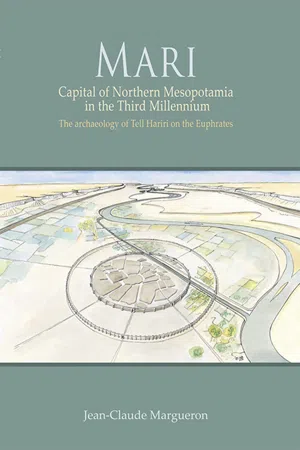
Mari
Capital of Northern Mesopotamia in the Third Millennium. The archaeology of Tell Hariri on the Euphrates
- 176 pages
- English
- PDF
- Available on iOS & Android
Mari
Capital of Northern Mesopotamia in the Third Millennium. The archaeology of Tell Hariri on the Euphrates
About This Book
According to archaeological evidence gleaned over more than 70 years, Mari appears to have been the most important city in northern Mesopotamia from its foundation at about 2950 BC to 1760 BC. Situated at the heart of a river system and progressively linked with an overland network, Mari was the city that controlled the relations of central and southern Mesopotamia with the regions bordering the Taurus and Zagros mountains to the north and east and the Mediterranean coastal zone to the west. Mari drew its power from this situation, and the role it played accounts for the particularity of its features, positioned as it was between the Syrian, Assyrian, Iranian, Babylonian and Sumerian worlds.The evidence shows that there was not one city of Mari, but three successive cities, each having specific features, although there is a striking permanence in the original forms. The first, City I, founded in about 2950 BC, was based on remarkable principles of city planning, including a broad regional development with the creation of canals for irrigation and transport, one more than 120 km long. In the 23rd century BC City II was founded using impressive technology in city planning. Probably destroyed by Naram-Sin of Akkad about 2200 BC, it was entirely reconstructed as City III by a new dynasty, the Shakkanakku. In the 19th century BC this was replaced by an Amorite dynasty, which ruled until Hammurabi of Babylon destroyed Mari in 1760 BC. The diversity of the information and material that has been recovered confirms Mari's place as one of the best sources for understanding the brilliant Mesopotamian civilisation that developed between the beginning of the 3rd and the end of the 1st millennium BC.
Frequently asked questions
Information
Table of contents
- Cover
- Title Page
- Copyright Page
- Dedication Page
- Contents
- Preface
- Acknowledgments
- Chapter 1: Presentation of the site
- Chapter 2: The foundation of Mari and regional development
- Chapter 3: The historical stages
- Chapter 4: The three cities and urbanism
- Chapter 5: The development of domestic architecture
- Chapter 6: The religious monuments
- Chapter 7: The palaces
- Chapter 8: The development of funerary practices
- Chapter 9: Objects and installations of everyday life
- Chapter 10: Court art, sacred art, popular art
- Chapter 11: The historical data provided by archaeology
- Glossary
- Bibliography